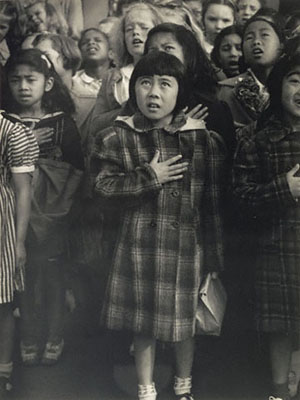 |
|
| Questions for Teaching |
• What is happening in this picture? What do you see that makes you say that? |
Background Information |
As far as Lange was concerned, her assignment from the United States government's War Relocation Authority (WRA) to document the Japanese-American evacuation process in northern California included picturing their lives in the San Francisco area before they were interned, as well as after. She made this image at a public school in April just days before citizens like this girl and her family were given numbers and transported to internment camps for the remainder of World War II. A group of schoolchildren are standing close together with their hands over their hearts and gazing upward, presumably at a flag. The image was cropped to draw attention to the girl in a plaid dress who stands front and center. Her expression is serious and shows strong emotion. |